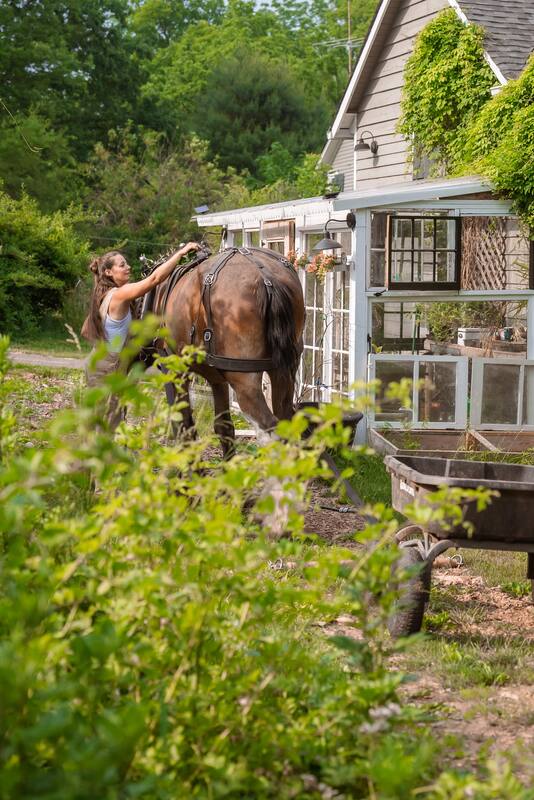|
Our Holland Lop rabbits live the good life outdoors (with shelter) all spring, summer and fall. They graze on cover crops from our raised beds and other food growing spaces by spring. Come summer and fall, they graze the pastures and laws with the ducks and geese from the safety of their bun run. And in the winter, they retire inside the old duck and goose coop for extra protection from the cold. I'm sharing my set up, bedding, and thoughts on winter rabbit housing.
You can find the Bun Run video here Permaculture Duck and Goose Living video here You can also find the products I mentioned from Eaton Pet & Pasture here: Hemp Pet Bedding Nesting Pads If you follow mythology (or just watch Thor movies) then you know that Odin is the one-eye god of war and death. This name is most fitting for the horse who almost lost his life at a killpen... and who is also blind in one eye.
Odin is a Belgian draft aged about 15-18 years old based on his teeth. I bought him sight unseen just a week before he was to be shipped from a Texas killpen to slaughter at a processing plant in Mexico. Aside from his lack of sight in one eye, he has rotting hooves from the muck he's been living in, which was stuck up to his pasterns. He has lice, is very underweight, and is covered in callouses from his work harness. And despite all of this, he's a gentle soul. I've already bathed Odin, removed the muck, and have started salves and antibiotic ointments on his wounds and eye swelling. His lice has been treated and he'll have a follow up dose in two weeks. His hooves will take work and time, but we will get there. We’ll schedule dental too. Even though he's clearly had a rough go at life, and traveled 3,000 miles to finally find his forever home, he's in good spirits. He's curious, friendly, and happy to have loads of hay all to himself. As requested, I will share my quarantine protocol in a post next week. And I will also share my new intensive rotational grazing plan for keeping 4 draft horses on 6 acres without sacrificing land stewardship. Yup… tomorrow, one more horse arrives I just couldn't pass up. Thanks for all the luck sent our way to get this boy here safely. Welcome home, Odin. Thank you to everyone who recommended horse auctions, pens, sanctuaries and organizations for me to browse. If you’re looking, there are some great rescues out there. And loads more where this guy came from at Last Chance Direct Ship horses on Facebook. They provide a list of trans-continental transportation companies upon purchase. Note these are horses that need rest and recovery before work. Last Chance Direct Ship Horses Colby’s Crew Storeybrook Farm Gentle Giants Draft Rescue Connecticut Draft Horse Rescue Castleton Ranch Horse Rescue Horses Deserve a Second Chance Cover cropping seems to be trendy and there's good reason for it--this "green manure" adds loads of nutrients and organic matter to gardens and growing spaces. I was suspicious the first time I was sowing cover crops; that there was more hype than real benefit. But I was shocked at the visible difference and improvement in my soil.
Cover crops are not harvestable like a vegetable or fruit crop. Instead, they're grown for the nutrients, cover, and tilth improvement they offer soil. In the fall cover crops can be sown into the garden. They grow and protect soil all winter long, preventing erosion, solarization, and runoff. Come spring, the cover crops are chopped and dropped, grazed, or removed (I have another video on that). Ideally the crop would be chopped and allowed to decompose in place. Any nutrients left in the plant during its lifecycle is returned to the soil as it decays, also increasing the amount of organic matter. I use a mix of cover crops to perform multiple functions; soil cover, weed reduction, to loosen compacted soil, to attract beneficial insects at spring thaw, fix nitrogen, phosphorous, potassium, and pull soluble nutrients up from soil layers. I purchased this pre-mixed blend from True Leaf Market. You can also research cover crop varieties and their benefits at the Rodale Institute's website and create your own blend. Time Stamps: Organizing Bulbs 0:53 / Permaculture Benefits 3:15 / Mulching with Hemp 4:42
This past May I visited a tulip farm out in Washington called Roozengaarde. I was intrigued by the blooms thriving in partial shade, under pine trees, and in visibly poor soil. Before getting caught up in the view and spending loads of money on bulb orders, I did a little research on the contributions tulips make to the permaculture garden (if any). Turns out, these beauties offer a lot more than just a view. Where I visited and purchased bulbs from: https://www.tulips.com/ Varieties I planted include Brisbane, La Belle Epoque, Frozen Night, Charming Beauty, Charming Lady, Red Princess, Louvre Orange, Black Hero, and Gudoshnik. Hemp mulch is from Eaton Pet and Pasture (chopped hemp animal bedding): https://www.amazon.com/Eaton-Hemp-Hypoallergenic-Sustainable-Eco-Friendly/dp/B08LQTRFG8 |
Angela is the farmer and content creator behind Axe & Root Homestead® LLC. This historic six-acre permaculture farm is home to two Clydesdale horses, ten honeybee hives, five sheep, two guardian dogs, barn cats and a flock of 40 geese and ducks. The farm produces maple syrup, fruit from a small orchard and loads of garden produce for consumption, preservation and donation to the local food pantry.
The Sustainable Homestead is available NOW!
Categories
All
|

